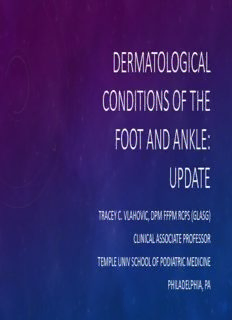
Tinea, Eczema, and All things Alike PDF
Preview Tinea, Eczema, and All things Alike
DERMATOLOGICAL CONDITIONS OF THE FOOT AND ANKLE: UPDATE TRACEY C. VLAHOVIC, DPM FFPM RCPS (GLASG) CLINICAL ASSOCIATE PROFESSOR TEMPLE UNIV SCHOOL OF PODIATRIC MEDICINE PHILADELPHIA, PA THIS MORNING’S AGENDA… • Various Inflammatory skin conditions • Verruca • Onychomycosis WHAT TYPICALLY WALKS INTO THE OFFICE: ERYTHRASMA We Need: Antimicrobial Soothing Anti-pruritic Wound healing HYPOCHLOROUS ACID KEY ATTRIBUTES Blocks histamine response Antimicrobial Activity • encourages wound healing Kills a broad spectrum of gram negative, • Clinical observations have shown reduced redness, gram positive, and yeast species in swelling, and irritation solution Wound Cleansing Enhanced Vascular Circulation • Effective debriding agent Better oxygenation at the wound site promotes faster • Physically breaks down biofilm healing Eliminates odor • Promotes granulation • Encourages epithelialization Non-cytotoxic • Increases blood flow to treated tissue HYPOCHLOROUS ACID SPRAY OR GEL (ALEVICYN, INTRADERM) • (Intraderm) Wound cleanser and antimicrobial agent, spray and hydrogel • Non-cytotoxic , anti-inflammatory, eliminates odor Case from Dr Fermin Martinez, 2007 HYPOCHORLOUS ACID SOLUTION (ALEVICYN, INTRADERM) • Antipruritic Hydrogel/Spray • Hypochlorous acid plus moisturizer foam or cream = steroid free regimen for pediatric patients R Smith, Poster at Caribbean Dermatology, Jan 2012 Using a non steroidal to soothe: Low molecular weight Hyaluronic Acid (Bionect, EPI Health) TYPICALLY, FOR INFLAMMATORY CONDITIONS… • The first line is a topical corticosteroid: • Class I drugs should be used for 2 weeks to 1 month with NO refills, remember side effects! • Titrate down • Prepare for flares • Add a barrier function cream • Goal: use little to no topical steroid ultimately Class I steroids: Clobetasol (Clobex, Olux, Temovate) Halobetasol (Ultravate) Betamethasone (Diprolene) Fluocinonide (Vanos) Diflorasone (Psorcon) REMEMBER…. • About the fingertip rule • It’s the concentration of the active ingredient at the specific site, not the amount put on the skin that affects percutaneous absorption
Description: